2021 HYUNDAI IONIQ ELECTRIC ECO mode
[x] Cancel search: ECO modePage 10 of 546
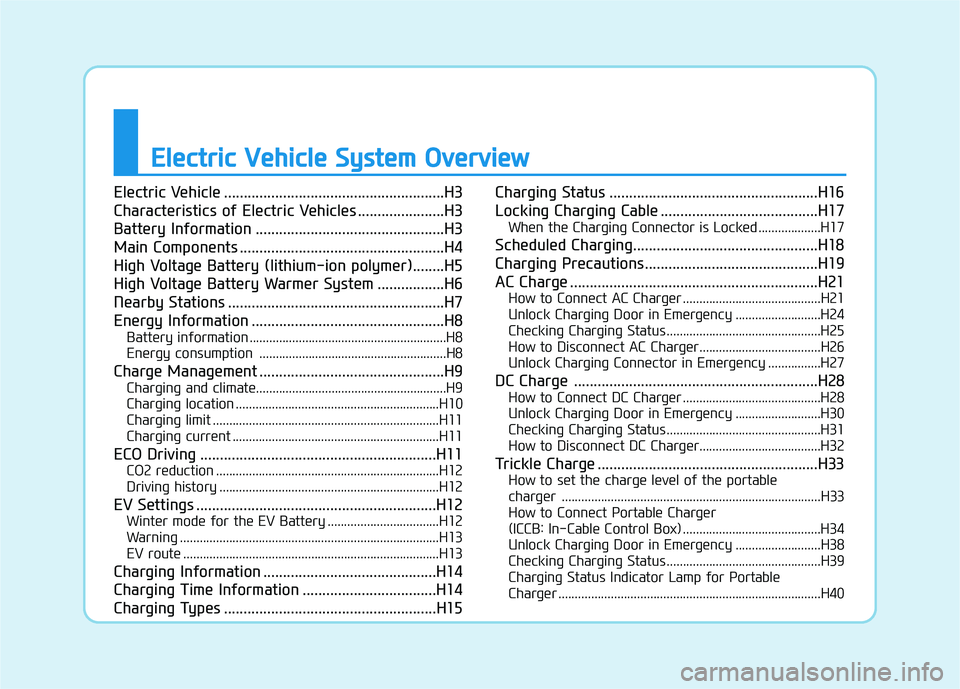
EEllee ccttrr iicc VV eehh iicc llee SS yyssttee mm OO vvee rrvv iiee ww
Electric Vehicle ........................................................H3
Characteristics of Electric Vehicles ......................H3
Battery Information ................................................H3
Main Components ....................................................H4
High Voltage Battery (lithium-ion polymer)........H5
High Voltage Battery Warmer System .................H6
Nearby Stations .......................................................H7
Energy Information .................................................H8
Battery information ............................................................H8
Energy consumption .........................................................H8
Charge Management ...............................................H9 Charging and climate..........................................................H9
Charging location ..............................................................H10
Charging limit .....................................................................H11
Charging current ...............................................................H11
ECO Driving ............................................................H11 CO2 reduction ....................................................................H12
Driving history ...................................................................H12
EV Settings .............................................................H12 Winter mode for the EV Battery ..................................H12
Warning ...............................................................................H13
EV route ..............................................................................H13
Charging Information ............................................H14
Charging Time Information ..................................H14
Charging Types ......................................................H15 Charging Status .....................................................H16
Locking Charging Cable ........................................H17
When the Charging Connector is Locked ...................H17
Scheduled Charging...............................................H18
Charging Precautions............................................H19
AC Charge ...............................................................H21 How to Connect AC Charger ..........................................H21
Unlock Charging Door in Emergency ..........................H24
Checking Charging Status ...............................................H25
How to Disconnect AC Charger.....................................H26
Unlock Charging Connector in Emergency ................H27
DC Charge ..............................................................H28 How to Connect DC Charger ..........................................H28
Unlock Charging Door in Emergency ..........................H30
Checking Charging Status ...............................................H31
How to Disconnect DC Charger.....................................H32
Trickle Charge ........................................................H33 How to set the charge level of the portable
charger ...............................................................................H33
How to Connect Portable Charger
(ICCB: In-Cable Control Box) ..........................................H34Unlock Charging Door in Emergency ..........................H38
Checking Charging Status ...............................................H39
Charging Status Indicator Lamp for Portable
Charger ................................................................................H40
Page 12 of 546

H3
Electric Vehicle
An electric vehicle is driven using a
battery and an electric motor. While
general vehicles use an internal
combustion engine and gasoline as
fuel, electric vehicles use electricalenergy that is charged inside the
high voltage battery. As a result,
electric vehicles are eco-friendly in
that they do not require fuel and do
not emit exhaust gases.
Characteristics of Electric
Vehicles
1. It is driven using the electricalenergy that is charged inside the
high voltage battery. This method
prevents air pollution since fuel,
like gasoline, is not required,
negating the emission of exhaust
gases.
2. A high performance motor is used in the vehicle as well. Compared
to standard, internal combustion
engine vehicles, engine noise and
vibrations are much more minimal
when driving.
3. When decelerating or driving downhill, regenerative braking is
utilized to charge the high voltage
battery. This minimizes energyloss and increases the distance to
empty.
4.When the battery charge is not suf- ficient, AC charge, DC charge and
trickle charge are available. (Refer
to “Charge Types for Electric
Vehicle” for details.) Information
What does regenerative braking do?
It uses the electric motor when decel-
erating or braking which transforms
vehicle motion (kinetic energy) to elec-
trical energy to charge the high volt-
age batteries. (Torque is applied in the
opposite direction when decelerating
to generate braking force and electric
energy.)
Battery Information
The vehicle is composed of a high voltage battery that drives the
motor and air-conditioner, and an
auxiliary battery (12 V) that drives
the lamps, wipers, and audio sys-tem.
The auxiliary battery is automati- cally charged when the vehicle is in
the ready ( ) mode or the high
voltage battery is being charged.
i
EELLEE CCTT RR IICC VV EEHH IICC LLEE
Page 14 of 546
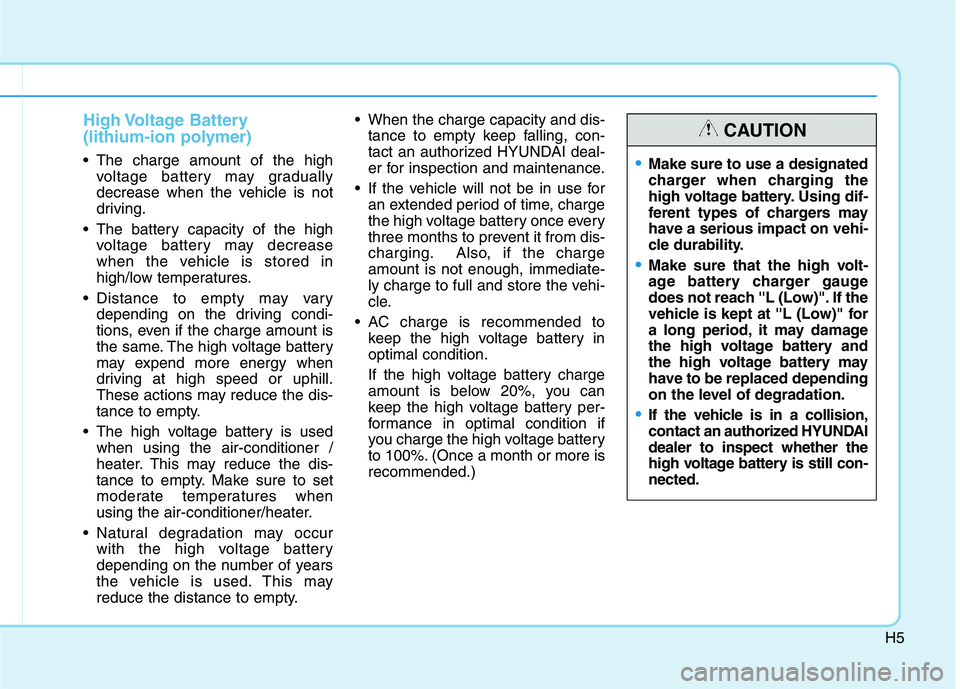
H5
High Voltage Battery
(lithium-ion polymer)
The charge amount of the highvoltage battery may gradually
decrease when the vehicle is not
driving.
The battery capacity of the high voltage battery may decrease
when the vehicle is stored in
high/low temperatures.
Distance to empty may vary depending on the driving condi-
tions, even if the charge amount is
the same. The high voltage battery
may expend more energy when
driving at high speed or uphill.
These actions may reduce the dis-
tance to empty.
The high voltage battery is used when using the air-conditioner /
heater. This may reduce the dis-
tance to empty. Make sure to set
moderate temperatures when
using the air-conditioner/heater.
Natural degradation may occur with the high voltage battery
depending on the number of years
the vehicle is used. This may
reduce the distance to empty. When the charge capacity and dis-
tance to empty keep falling, con-
tact an authorized HYUNDAI deal-
er for inspection and maintenance.
If the vehicle will not be in use for an extended period of time, charge
the high voltage battery once every
three months to prevent it from dis-
charging. Also, if the chargeamount is not enough, immediate-
ly charge to full and store the vehi-
cle.
AC charge is recommended to keep the high voltage battery inoptimal condition.
If the high voltage battery charge
amount is below 20%, you can
keep the high voltage battery per-
formance in optimal condition if
you charge the high voltage battery
to 100%. (Once a month or more isrecommended.)Make sure to use a designated
charger when charging the
high voltage battery. Using dif-
ferent types of chargers may
have a serious impact on vehi-
cle durability.
Make sure that the high volt-
age battery charger gauge
does not reach ''L (Low)". If the
vehicle is kept at ''L (Low)" for
a long period, it may damage
the high voltage battery and
the high voltage battery may
have to be replaced depending
on the level of degradation.
If the vehicle is in a collision,
contact an authorized HYUNDAIdealer to inspect whether the
high voltage battery is still con-nected.
CAUTION
Page 16 of 546
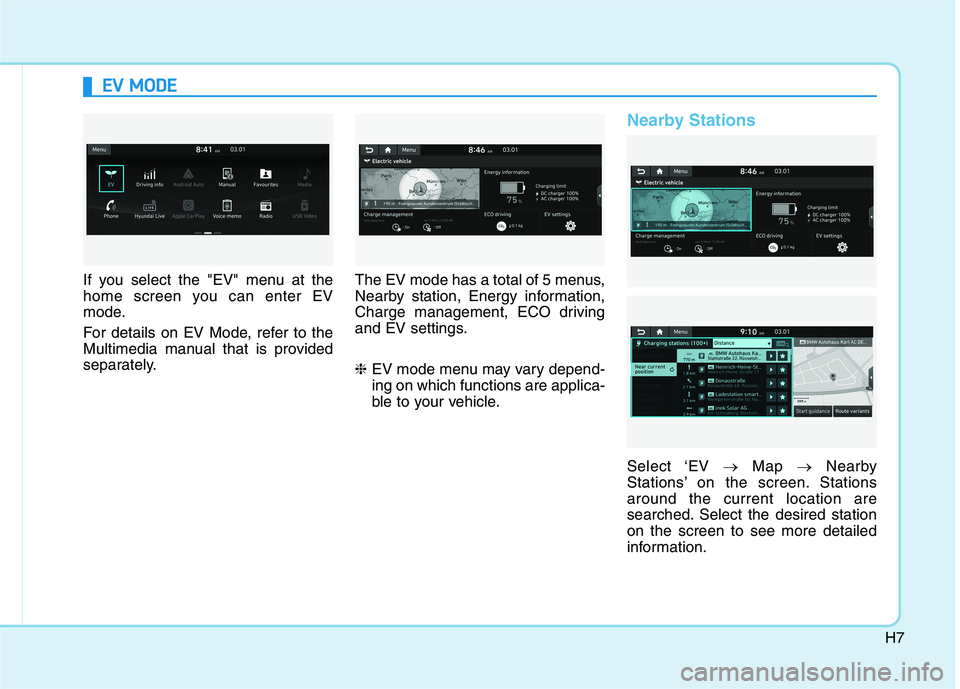
H7
If you select the "EV" menu at the
home screen you can enter EV
mode.
For details on EV Mode, refer to the
Multimedia manual that is provided
separately.The EV mode has a total of 5 menus,
Nearby station, Energy information,
Charge management, ECO driving
and EV settings. ❈
EV mode menu may vary depend- ing on which functions are applica-
ble to your vehicle.
Nearby Stations
Select ‘EV �Map �Nearby
Stations’ on the screen. Stations around the current location are
searched. Select the desired stationon the screen to see more detailed
information.
EE VV MM OODDEE
Page 21 of 546
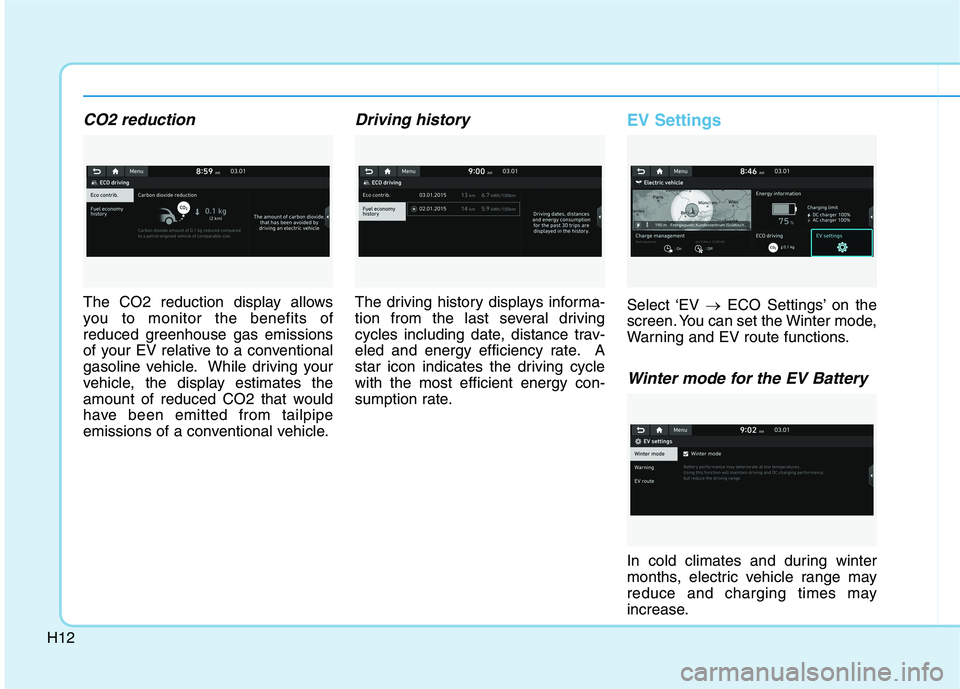
H12
CO2 reduction
The CO2 reduction display allows
you to monitor the benefits of
reduced greenhouse gas emissions
of your EV relative to a conventional
gasoline vehicle. While driving your
vehicle, the display estimates the
amount of reduced CO2 that would
have been emitted from tailpipe
emissions of a conventional vehicle.
Driving history
The driving history displays informa-
tion from the last several driving
cycles including date, distance trav-
eled and energy efficiency rate. A
star icon indicates the driving cyclewith the most efficient energy con-
sumption rate.
EV Settings
Select ‘EV �ECO Settings’ on the
screen. You can set the Winter mode,
Warning and EV route functions.
Winter mode for the EV Battery
In cold climates and during winter
months, electric vehicle range may
reduce and charging times may
increase.
Page 22 of 546
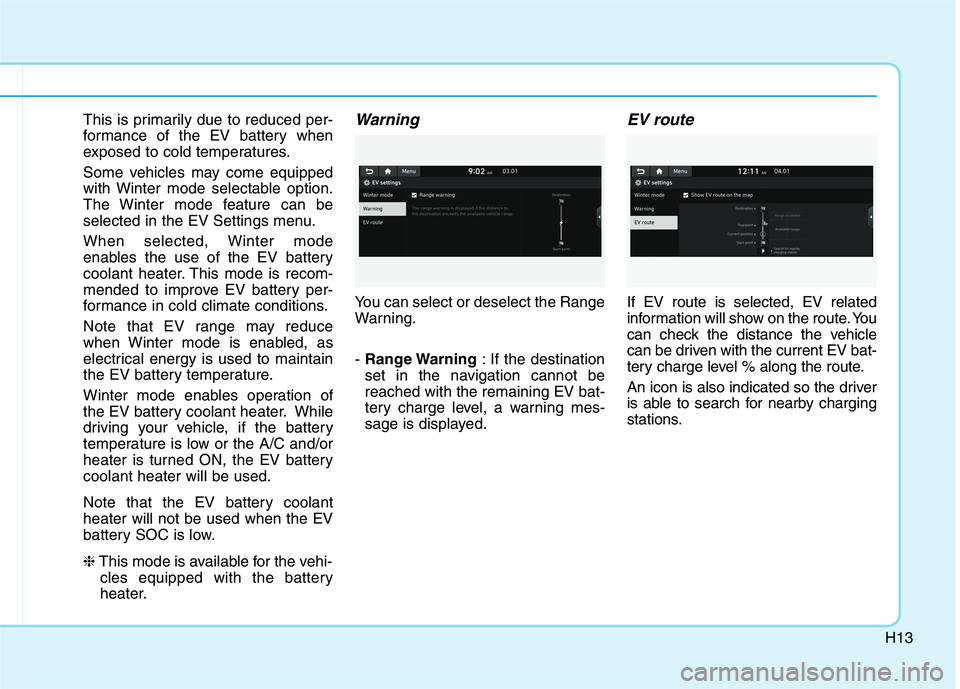
H13
This is primarily due to reduced per-
formance of the EV battery when
exposed to cold temperatures.
Some vehicles may come equipped
with Winter mode selectable option.
The Winter mode feature can be
selected in the EV Settings menu.
When selected, Winter mode
enables the use of the EV battery
coolant heater. This mode is recom-
mended to improve EV battery per-
formance in cold climate conditions.
Note that EV range may reduce
when Winter mode is enabled, as
electrical energy is used to maintain
the EV battery temperature.
Winter mode enables operation of
the EV battery coolant heater. While
driving your vehicle, if the battery
temperature is low or the A/C and/or
heater is turned ON, the EV batterycoolant heater will be used.
Note that the EV battery coolant heater will not be used when the EV
battery SOC is low. ❈This mode is available for the vehi-
cles equipped with the battery
heater.Warning
You can select or deselect the Range
Warning. - Range Warning : If the destination
set in the navigation cannot be reached with the remaining EV bat-
tery charge level, a warning mes-
sage is displayed.
EV route
If EV route is selected, EV related
information will show on the route. You
can check the distance the vehicle
can be driven with the current EV bat-
tery charge level % along the route.
An icon is also indicated so the driver
is able to search for nearby charging
stations.
Page 57 of 546
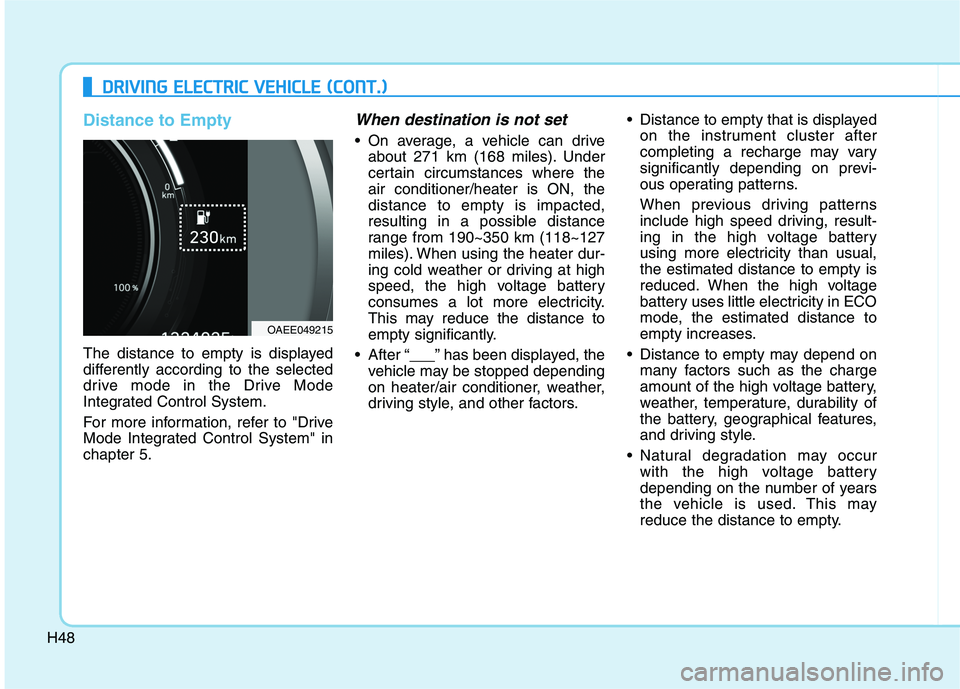
H48
Distance to Empty
The distance to empty is displayed
differently according to the selected
drive mode in the Drive Mode
Integrated Control System.
For more information, refer to "Drive
Mode Integrated Control System" inchapter 5.
When destination is not set
On average, a vehicle can driveabout 271 km (168 miles). Under
certain circumstances where theair conditioner/heater is ON, thedistance to empty is impacted,
resulting in a possible distance
range from 190~350 km (118~127
miles). When using the heater dur-
ing cold weather or driving at high
speed, the high voltage battery
consumes a lot more electricity.
This may reduce the distance to
empty significantly.
After “___” has been displayed, the vehicle may be stopped depending
on heater/air conditioner, weather,
driving style, and other factors. Distance to empty that is displayed
on the instrument cluster after
completing a recharge may vary
significantly depending on previ-
ous operating patterns.
When previous driving patterns
include high speed driving, result-
ing in the high voltage battery
using more electricity than usual,the estimated distance to empty is
reduced. When the high voltage
battery uses little electricity in ECO
mode, the estimated distance to
empty increases.
Distance to empty may depend on many factors such as the charge
amount of the high voltage battery,
weather, temperature, durability of
the battery, geographical features,
and driving style.
Natural degradation may occur with the high voltage battery
depending on the number of years
the vehicle is used. This may
reduce the distance to empty.
DDRRIIVV IINN GG EE LLEE CCTT RR IICC VV EEHH IICC LLEE (( CC OO NNTT..))
OAEE049215
Page 73 of 546
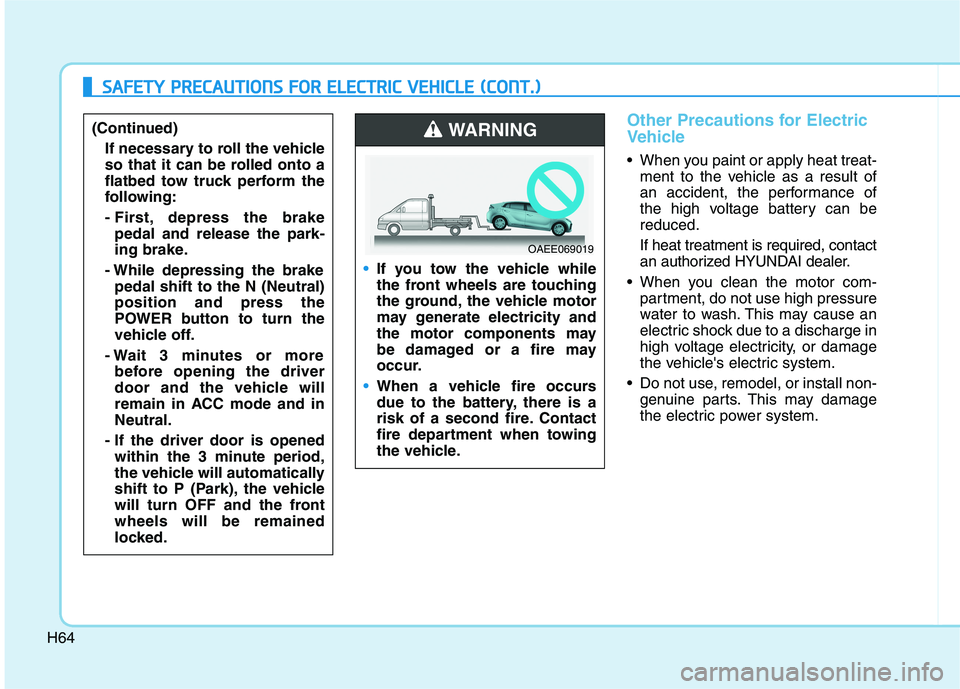
H64
Other Precautions for Electric
Vehicle
When you paint or apply heat treat-ment to the vehicle as a result of
an accident, the performance of
the high voltage battery can bereduced. If heat treatment is required, contact
an authorized HYUNDAI dealer.
When you clean the motor com- partment, do not use high pressure
water to wash. This may cause an
electric shock due to a discharge in
high voltage electricity, or damage
the vehicle's electric system.
Do not use, remodel, or install non- genuine parts. This may damage
the electric power system.
If you tow the vehicle while
the front wheels are touching
the ground, the vehicle motor
may generate electricity and
the motor components may
be damaged or a fire may
occur.
When a vehicle fire occurs
due to the battery, there is a
risk of a second fire. Contact
fire department when towing
the vehicle.
WARNING
OAEE069019
SSAA FFEE TT YY PP RR EECCAA UU TTIIOO NNSS FF OO RR EE LLEE CCTT RR IICC VV EEHH IICC LLEE (( CC OO NNTT..))
(Continued)
If necessary to roll the vehicle
so that it can be rolled onto a
flatbed tow truck perform the
following:
- First, depress the brakepedal and release the park-
ing brake.
- While depressing the brake pedal shift to the N (Neutral)position and press the
POWER button to turn the
vehicle off.
- Wait 3 minutes or more before opening the driver
door and the vehicle will
remain in ACC mode and inNeutral.
- If the driver door is opened within the 3 minute period,
the vehicle will automatically
shift to P (Park), the vehicle
will turn OFF and the frontwheels will be remained
locked.